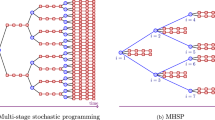Abstract
In the traditional project crashing problem (also known as the time-cost tradeoff problem) associated with a project network, the decision variables are assumed to be continuous, representing the amount of reduction in the duration of the tasks in the project, and the objective is to find the least expensive set of time reductions (“crashing” times) to complete the project within a given time limit (to avoid penalties). We will study a variant of this problem with a combinatorial probabilistic version, where the objective is to find the set of “crashing” choices that minimizes the time reduction cost and the expected penalty risk from tardiness. We show this problem is NP-hard, so we propose efficient heuristics that can provide approximate solutions to this problem. We also extend this problem so that resource assignments can be adjusted following project status reviews several times before reaching the project deadline.



Similar content being viewed by others
References
Ahuja, R. K., Magnanti, T. L., & Orlin, J. B. (1993). Network flows: Theory, algorithms, and applications. Englewood Cliffs, NJ: Prentice-Hall Inc.
Bowman, R. A. (1994). Stochastic gradient-based time-cost tradeoffs in \(\text{ PERT }\) networks using simulation. Annals of Operations Research, 53(1), 533–551.
Diaby, M., Cruz, J. M., & Nsakanda, A. L. (2011). Project crashing in the presence of general non-linear activity time reduction costs. International Journal of Operational Research, 12(3), 318–332.
Fazar, W. (1959). Program evaluation and review technique. The American Statistician, 13(2), 10.
Fulkerson, D. R. (1961). A network flow computation for project cost curves. Management Science, 7(2), 167–178.
Garey, M. R., & Johnson, D. S. (1979). Computers and intractability. New York, NY: W. H. Freeman and Company.
Goh, J., & Hall, N. G. (2013). Total cost control in project management via satisfying. Management Science, 59(6), 1354–1372.
Gutjahr, W. J., Strauss, C., & Wagner, E. (2000). A stochastic branch-and-bound approach to activity crashing in project management. INFORMS Journal On Computing, 12(2), 125–135.
Kelley, J. E., & Walker, M. R. (1959). Critical-path planning and scheduling. In Proceedings IRE-AIEE-ACM computer conference, pp. 160–173.
Kerzner, H. (2013). Project management: A systems approach to planning, scheduling and controlling (eleventh ed.). New York, NY: Wiley.
Lawler, E. (2001). Combinatorial optimization, networks and matroids. New York: Dover Publications Inc.
Malcolm, D. G., Roseboom, J. H., Clark, C. E., & Fazar, W. (1959). Application of a technique for research and development program evaluation. Operations Research, 7(5), 646–669.
Mitchell, G., & Klastorin, T. (2007). An effective methodology for the stochastic project compression problem. IIE Transactions, 39, 957–969.
Shtub, A., Bard, J., & Globerson, S. (2005). Project management: Processes, methodologies, and economics (2nd ed.). Englewood Cliffs, NJ: Prentice-Hall Inc.
Author information
Authors and Affiliations
Corresponding author
Appendix: Complexity analysis
Appendix: Complexity analysis
In this section we show that the yes-no decision version of the project crashing problem is NP-complete, and so, the combinatorial optimization version of the problem is NP-hard. We define an instance of the deterministic project crashing problem (DPC) as a collection of the following objects:
-
1.
a project network \(G=(N, A)\), \(|N|=n\), \(|A|=m\);
-
2.
a collection of nonempty finite choice sets \(S_{i}\) such that \(\mu _{ij}\) is the (deterministic) duration of task i for every choice \(j\in S_{i}\);
-
3.
choice costs \(c_{ij}\) for all \(i\in N\) and \(j\in S_{i}\); and
-
4.
a desired time duration d.
Given an integer instance of DPC and a non-negative integer K, the yes-no decision version of the problem consists of answering the following question:
Are there n indexes \(j_{i}\in S_{i}\) for each \(i\in N\) such that \(\sum _{i\in N}c_{ij_{i}}\le K\) and the overall project duration with task durations \(\mu _{ij_{i}}\) is less than or equal to d?
Proposition 1
The yes-no decision version of DPC is NP-complete.
Proof
The problem is in the NP class because, given a “yes” instance of yes-no DPC, a certificate of feasibility is a list of n indexes indicating the time duration choices for each task. Clearly, such a list requires a polynomial amount of storage in terms of n and \(\max _{i\in N}\{|S_{i}|\}\). Checking that the total cost of the choices in the list is less than K can be clearly done in polynomial time. Moreover, since the project network is acyclic, finding the longest path to compute the overall project duration can be done in polynomial time in terms of m and n, and so, checking the certificate for feasibility only requires a polynomial number of operations in terms of the size of the data instance.
To complete the proof, we show that any instance of the yes-no Knapsack problem can be polynomially reduced to an instance of the yes-no DPC. Since yes-no Knapsack is NP-complete Garey and Johnson (1979), it would follow that yes-no DPC is also NP-complete. An instance of yes-no Knapsack consists of a finite index set \(U=\{1,\ldots ,\hat{u}\}\), non-negative integer values \(v_{u}, w_{u}\) for all \(u\in U\), and non-negative integers B and C. The problem consists of answering the following question: Is there a subset \(\hat{U}\subset U\) such that \(\sum _{u\in \hat{U}}v_{u}\le B\) and \(\sum _{u\in \hat{U}}w_{u}\ge C\)?
Given an instance of yes-no Knapsack, we construct an instance of yes-no DPC as follows: set \(N=U\), \(A:=\{(i,i+1):1\le i\le \hat{u}-1\}\), \(s:=1\), and \(t:=\hat{u}\). The resulting project network corresponds to a series of \(\hat{u}\) consecutive tasks. For every task \(i\in N\), set \(S_{i}:=\{1,2\}\), that is two choices for each task. The first choice is \((\mu _{i1},c_{i1})=(w_{i},0)\), and the second choice is \((\mu _{i2},c_{i2})=(0,v_{i})\) for all \(i\in N\). Finally, set \(d:=\sum _{i\in N}w_{i}-C\) and \(K:=B\).
If the yes-no Knapsack is a yes-instance, then there exists a set \(\hat{U}\subset U=N\) such that \(\sum _{i\in \hat{U}}v_{i}\le B\) and \(\sum _{i\in \hat{U}}w_{ui}\ge C\). Hence, consider an index assignment for the corresponding yes-no DPC instance of the form \(j_{i}:=2\) if \(i\in \hat{U}\) and \(j_{i}=1\) if \(i\notin \hat{U}\). Clearly, we have \(\sum _{i\in N}c_{ij_{i}}=\sum _{i\in \hat{U}}v_{i}\le B = K\). Since there is only one path from s to t in the project network, it follows that the project duration is \(\sum _{i\in N}\mu _{ij_{i}}\). Moreover, \(\sum _{i\in N}\mu _{ij_{i}}=\sum _{i\notin \hat{U}}w_{i}=\sum _{i\in N}w_{i}-\sum _{i\in \hat{U}}w_{i} \le \sum _{i\in N}w_{i}-C = d\). Therefore, the yes-no DPC instance is also a yes-instance. Conversely, using similar inequalities it is easy to see that if the yes-no DPC instance associated with the given yes-no Knapsack instance is a yes-instance, then by taking \(\hat{U}:=\{i\in N: j_{i}=2\}\) we can show that the Knapsack instance is also a yes-instance.
Finally, the result follows from observing that the instance transformation from yes-no Knapsack to yes-no DPC described above is polynomial in the size of the Knapsack instance.\(\square \)
Next, we show that problem DEPC\(_0\) is also NP-hard.
Corollary 1
The yes-no decision (rational) version of DEPC\(_0\) is NP-complete.
Proof
The yes-no decision version of DEPC\(_0\) is: given a deterministic crashing problem instance (as defined above) and a positive rational penalty w,
Are there n indexes \(j_{i}\in S_{i}\) for each \(i\in N\) and a nonnegative integer r such that \(\sum _{i\in N}c_{ij_{i}}+w r\le K\) and the overall project duration with task durations \(\mu _{ij_{i}}\) is less than or equal to \(d+r\)?
It is easy to see that a certificate of feasibility for a “yes” instance is a list of indexes indicating choices for each task and a nonnegative integer not greater than K / w to represent the value of r. Checking the certificate only requires a polynomial number of operations in terms of the size of the data instance. Hence, the problem is in the NP class.
To complete the proof take a yes-no instance of DPC and construct an instance of DEPC\(_0\) by keeping all parameters the same and setting \(w:=K+1\). Since there cannot be a positive integer r satisfying \(\sum _{i\in N}c_{ij_{i}}+w r\le K\) for any set of indexes \(j_{i}\), it is easy to see that the DPC instance polynomially reduces to this DEPC\(_0\) instance.\(\square \)
Finally, as before notice that problem DEPC\(_0\) is a particular case of problem EPC\(_0\) by taking \(\sigma _{ij}=0\). Thus, we obtain the following corollary.
Corollary 2
Problem EPC\(_0\) is NP-hard.
Rights and permissions
About this article
Cite this article
Nunez, M.A., Kuo, L. & Chiang, I.R. Managing risk-adjusted resource allocation for project time-cost tradeoffs. Ann Oper Res 317, 717–735 (2022). https://doi.org/10.1007/s10479-016-2122-7
Published:
Issue Date:
DOI: https://doi.org/10.1007/s10479-016-2122-7




